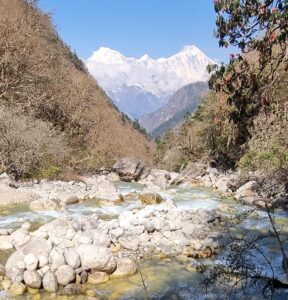Ice-pop: synthesising models of future glacier runoff and population change
Many of the world’s largest rivers originate in glaciated mountain ranges, with an estimated 1.9 billion people (i.e. ~25% of world’s total population) at risk of being negatively impacted by future runoff changes due to glacier mass loss (Immerzeel et al., 2019). In these regions, glacier meltwater contributes to and modulates the discharge of rivers. This influences freshwater availability for drinking and irrigation, hydropower operations, ecology and geomorphology. Glacier mass loss alters the hydrological regime, a process already observed in many catchments, with further detrimental changes expected. Even low levels of glaciation can have a significant impact on river flow, with basins of <1% glacierised area experiencing meltwater contributions exceeding 25% in individual months (Huss and Hock, 2018). Many regions at risk of changing water resources coincide with areas of low socioeconomic development, which are also projected to experience population growth. Understanding the interplay between glaciology, hydrology and socioeconomics will be vital for ensuring water security and developing targeted mitigation strategies.

The headwaters of the Marsyangdi River, Nepal
This is a truly interdisciplinary project investigating the burden of changes in water resources due to glacier retreat. The project will synthesise leading research in glaciology and socio-demographics, utilising newly available datasets and techniques for data analysis. This will involve developing fine scale models of hydrological response alongside population and socio-demographic change. An initial global scale assessment of vulnerability will be used to identify catchments most at risk. For these locations, detailed analysis will be performed to investigate the social, ecological and geomorphological impacts of modified runoff. This will be placed within the context of other potential threats such as changes to the precipitation regime, evaporation rates, land use change, lake formation and outburst floods. These results will be used to quantify the impact of a changing hydrological regime due to glacier retreat and inform policy, adaptation and mitigation strategies.
The project aims are:
- To develop a global scale modelling approach that allows catchment risk to be assessed in terms of hydrological response to future ice loss and changing population/socio-economics.
- For catchments found to be most vulnerable from 1), perform and in depth analysis to determine potential social, ecological and geomorphological impacts
- Develop catchment specific policy recommendations, adaptation and mitigation strategies
This will require:
- The construction and synthesis of global scale, high resolution datasets of present and future ice volume, terrain, population and socio-economic variables
- The development of a GIS based algorithm to delineate individual catchments, calculate hydrological response, socio-economic and environmental parameters
- Liaising with stakeholders to develop suitable policy recommendations, adaption and mitigation strategies
This project is closely aligned to the United Nations Sustainable Development Goals, most notably Goal 6: ‘Ensure access to water and sanitation for all’ and Goal 13: ‘Take urgent action to combat climate change and its impacts’. The framework and methodology will identify specific catchments at high risk, thus allowing the targeted provision of resources and mitigation strategies. The direct impact of this work will be with organisations responsible for water resource management: water supply companies, governments, local authorities and NGO’s. The ultimate beneficiaries will be the people living within the areas of high water vulnerability.
References
Beniston, M. Climatic change in mountain regions: a review of possible impacts. in Climate variability and change in high elevation regions: Past, present & future 5–31 (Springer, 2003)
Huss, M. & Hock, R. Global-scale hydrological response to future glacier mass loss. Nat. Clim. Chang. 8, 135 (2018).
Immerzeel, W. W., Lutz, A. F., Andrade, M., Bahl, A., Biemans, H., Bolch, T., Hyde, S., Brumby, S., Davies, B. J. and Elmore, A. C. (2019) ‘Importance and vulnerability of the world’s water towers’, Nature. doi: doi.org/10.1038/s41586-019-1822-y.
